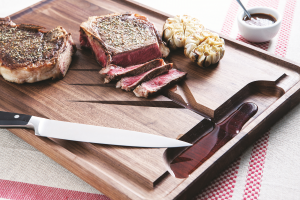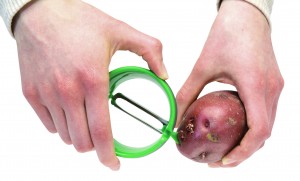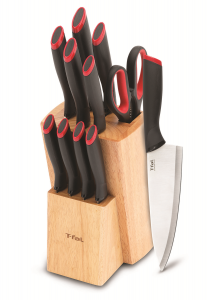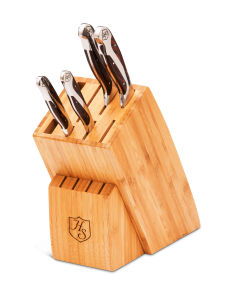The Knife Rack
Chef Quality Knives Appear in the Home Kitchen
By Micah Cheek
There’s a lot of mystique around the chef’s knife. The all-purpose blade is one of the great kitchen essentials, giving it the kind of notoriety that gets it tattooed on the arms of culinary school students en masse. With this kind of mystique, it’s no wonder that kitchen knives are starting to blur the lines between tools and works of art. Chefs and home cooks alike are looking for knives that are as beautiful as they are sharp.
 Zack Worrell, Founder and Owner of Monolith Knives, is part of a community of creators of artfully crafted knives. “The [artisan] culinary knife movement is only about 12 years old. The true leader of it is Bob Kramer. He went out and started doing this in the 1990s. He had worked in restaurants all his life, and he wanted a knife that was better than anything he could find,” says Worrell. “I think the industry is definitely on fire, there’s huge room for growth.” Monolith Knives creates custom culinary blades in Charlottesville, Virginia. Many chefs, including some James Beard Award-winners, have sought Monolith out for their rustic designs and unusual handles.
Zack Worrell, Founder and Owner of Monolith Knives, is part of a community of creators of artfully crafted knives. “The [artisan] culinary knife movement is only about 12 years old. The true leader of it is Bob Kramer. He went out and started doing this in the 1990s. He had worked in restaurants all his life, and he wanted a knife that was better than anything he could find,” says Worrell. “I think the industry is definitely on fire, there’s huge room for growth.” Monolith Knives creates custom culinary blades in Charlottesville, Virginia. Many chefs, including some James Beard Award-winners, have sought Monolith out for their rustic designs and unusual handles.
Knife buyers are informed enough about knife materials and quality that they find value in the special materials Monolith sources. “Some of the steel we get to work with is so amazing,” says Worrell. “We use both carbon steel and stainless steel, and carbon Damascus and stainless Damascus. We buy it from curated boutique shops in the United States and a company from Sweden called Damasteel. It’s one of the most high-performance steels on the market.”
For customers who are looking for rare and special building materials, knife makers can use materials with a story, including steel from the leaf spring suspensions of classic muscle cars. “We also use reclaimed metal. We try to pick cool cars so we can tell a story. We did some last year that were all made from a ’69 Mustang. We anneal the steel, normalize and later re-harden and temper the steel – all part of the crucial heat-treating process. That’s like giving it a new life.”
When looking into handcrafted knives, it is important to make sure that they were created from responsibly sourced materials. “Export laws are changing. There’s a type of wood that’s really rare called desert ironwood – people cut it out of protected lands in Arizona, and when you go to a knife show you’ll see tables full of it,” says Worrell. “You see some stuff at shows like elephant tusk and coral – it really has no place here. There’s a lot of exotic wood that comes into the country that isn’t regulated.”
Customers will respond to more ecologically friendly materials that tell a story. And those materials don’t have to come from an iconic muscle car. “For us, using domestic wood is cool. We find stuff that’s semi-rotted and then inject it with resin and dyes, and then it looks super cool. Locally sourced means so much more to people,” Worrell says. “There’s this big orange tree in my front yard – when Meriwether Lewis came home from his expedition with James Clark, he brought home Osage orange. I have a bunch of wood that has come from James Monroe’s house here in Virginia, and James Madison’s, and Thomas Jefferson’s at Monticello. It’s amazing wood.”
Resin handles are growing in popularity because they open up lots of opportunities for interesting patterns and styles. “There’s trends like resin handles, they’ve been a big thing. We do a lot of experimentation with that. The resin casting stuff is pretty cool – it lets us get into the full picture of the knife,” says Worrell. Monolith makes its own handles in a style similar to Micarta, which is produced by laminating linen soaked in resin. After sanding, the resulting handle is light, sturdy and watertight. These resin handles are especially appealing to people working in kitchens, thanks to its resistance to water and bacteria.
Figuring out how to do a retail business in handcrafted knives can be tough. “Sometimes we have retailers who want to carry our stuff. Sometimes it gets difficult to be able to meet their expectations for material,” says Worrell. “We’re still a small business, so margins are tight. We work with people who are willing to get us a better points spread on our margin, and then we can handle the drop ship and everything for them, and they’re just committing to a certain number of sales per year.”
More exciting designs are also available for consumers looking for bold designs that require less of an investment. Cangshan Cutlery has been producing wood handles and sheaths which have proven popular with an educated audience. “Wood is very much on trend right now, we’re very aware of it. The problem with wood in knives is the sanitation issue. If people don’t have great sanitation practices, that can be a problem.” says Christopher Saunders, Creative Director, Cangshan Cutlery.
“We do talk about maintenance of the wood, oiling it periodically, and the fact that you have to take care of it more. We’re building on those materials to educate the people who buy our knives,” adds Rob Walling, National Sales Manager, Cangshan Cutlery.
A functional and beautiful chef’s knife can take the place of many other blades in the kitchen. “I think minimalism is becoming popular. Kitchens are getting smaller. We’re pushing for an essential knife block, not with 20 knives you never use,” says Saunders, who points out that Millennials in smaller living spaces will be looking for attractively designed essentials. “The younger generation is looking for something that’s a little more space saving. But I tell you what, a 23-piece NI Series knife set sitting in your kitchen makes a bold statement,” says Walling.
Going into the future, Saunders expects smooth lines and bold tones to play an even greater part in knife design. “I think probably more minimalistic styles are going to be big, possibly even more artistic, playing with bold colors and wood,” says Saunders.
Between Blocks and Boards
By Micah Cheek
 When I met Kristine McCutcheon from Larch Wood Enterprises, I spoke without thinking. I asked, “Can you talk to me a little bit about these cutting boards?” McCutcheon was quick with the response. “These aren’t cutting boards, they’re butcher blocks.” Lots of consumers treat butcher blocks and cutting boards as synonyms, but differences in grain, thickness and structure can inform what a board can handle. “They have different structures for different purposes. Boards are for serving and blocks are for cutting,” McCutcheon added. She went on to explain how different types of boards are designed for different tasks.
When I met Kristine McCutcheon from Larch Wood Enterprises, I spoke without thinking. I asked, “Can you talk to me a little bit about these cutting boards?” McCutcheon was quick with the response. “These aren’t cutting boards, they’re butcher blocks.” Lots of consumers treat butcher blocks and cutting boards as synonyms, but differences in grain, thickness and structure can inform what a board can handle. “They have different structures for different purposes. Boards are for serving and blocks are for cutting,” McCutcheon added. She went on to explain how different types of boards are designed for different tasks.
Traditionally, butcher blocks are made with end grains. An end grain faces towards the top of the board rather than along its length. Wood is made of individual fibers, and when the end grain is facing up, all of those fibers are standing vertically. On the molecular level, the knife’s edge cuts between these filaments rather than across them. This can be demonstrated with spaghetti. If you have some dry spaghetti standing vertically, and some lying down horizontally, it’s easier to put a knife through the vertical strands, because the knife moves between them rather than having to cut through. Over time, this means fewer deep cuts and grooves in the board’s surface, as the wood fibers close up around knife incisions. Many butcher blocks are also thicker, to insulate against the impact of a knife. Some boards, like the Traditional Butcher Blocks from John Boos, can measure 10 inches thick and come equipped with legs to stand on.
While the butcher block is designed for heavy chopping and fabricating, cutting and serving boards are made for more gentle use. Cutting boards are usually made with the grain going lengthwise, rather than up and down. This makes for a harder surface to cut on, but highlights beautiful long lines along the wood grain. These boards also tend to be thinner than butcher blocks and light enough to carry to the table. As this build requires less cutting and fabricating, edge grain boards tend to be less expensive as well.
Two seasons ago, JK Adams redesigned its butcher blocks with features to make it easier to navigate around the kitchen. “On our end grain boards, we tried to add more features. [We added] silicone feet to protect countertops, juice grooves, and handles or undercuts that allow someone to move or carry them around a little easier,” says Jon Blatchford, CEO of JK Adams. These changes further blur the line between blocks and boards, making a block that is easy to carry, which makes it easy to serve on. There is some discussion on how grain alignment can affect a knife’s blade over time, but Blatchford notes that for knife edges, the grain orientation matters less than the material itself. “Hardwood is the key,” he notes. “[Compared to] plastic, bamboo or synthetic materials, hardwood tends to be the best on a knife blade and is the most sanitary.”
The care and maintenance regimens for cutting boards and butcher blocks are very similar. In addition to hand washing and immediate towel drying, all wood boards need to be conditioned with mineral oil or a food-safe, wax-based wood conditioner. “The more you oil them, the better they’re going to be,” says Blatchford. “You’re truly making an investment that you’re going to only make one time if you treat them well.”
Microplane Debuts New Grip’n Strip Fruit and Vegetable Peeler
 Microplane®’s new Grip’n Strip, an innovatively designed vegetable and fruit peeler, joins the company’s growing collection of sharp and efficient premium kitchen gadgets. Crafted in two blade styles — Serrated and Straight — and three colors, including black, red and green, the Grip’n Strip will be available in September 2017 for a suggested retail price of $7.98.
Microplane®’s new Grip’n Strip, an innovatively designed vegetable and fruit peeler, joins the company’s growing collection of sharp and efficient premium kitchen gadgets. Crafted in two blade styles — Serrated and Straight — and three colors, including black, red and green, the Grip’n Strip will be available in September 2017 for a suggested retail price of $7.98.
The Grip’n Strip features a unique multi-positional round shape that makes it possible to grip the tool any way that’s most comfortable for the user. Perfect for anyone, whether right or left-handed, the Grip’n Strip’s ergonomically wide and circular design also makes it an ideal tool for people with arthritic hands. Fast, efficient and simple to use, the Grip’n Strip’s razor-sharp twin blades swivel and self-adjust to the surface of each ingredient being peeled for optimum results. Grip’n Strip’s serrated blade features sharp teeth that firmly grasp and efficiently peel the smooth skin of soft foods, such as tomatoes, kiwis and peaches. The straight blade version of the Grip’n Strip effectively peels an array of vegetables and fruits with thin and thicker skins, such as potatoes, carrots and cucumbers. Incorporated into the new prep tool is a small protruding piece that effectively removes potato eyes and other blemishes.
Dishwasher safe, the Microplane Grip’n Strip comes with a reusable, hand-washable cover to protect the blade in storage. For more information, visit www.microplane.com or call toll-free 800.555.2767.
T-Fal Comfort Cutlery
 T-fal has introduced a new knife set and block. This T-fal Comfort Knife set features high carbon stainless steel blades for everyday use, in a set that will complete any kitchen. The ergonomic handles are designed with a “comfort zone” specifically positioned at the two touch points, bolster and underbelly, for optimum grip and control. On top of that, the end of each handle is marked with blade type for hesitation-free selection during food prep. Hand washing is recommended for these knives.
T-fal has introduced a new knife set and block. This T-fal Comfort Knife set features high carbon stainless steel blades for everyday use, in a set that will complete any kitchen. The ergonomic handles are designed with a “comfort zone” specifically positioned at the two touch points, bolster and underbelly, for optimum grip and control. On top of that, the end of each handle is marked with blade type for hesitation-free selection during food prep. Hand washing is recommended for these knives.
Hammer Stahl Gets Sharp about Knives: Introducing the Essential Five-Piece Cutlery Set for the Home Cook
Hammer Stahl, a company which manufactures professional-quality American Clad stainless steel cookware in Clarksville, Tennessee, has introduced a five-piece cutlery set with a knife block that can be customized based on a consumer’s cutlery preferences and budget. The new cutlery set includes the most essential and versatile knives needed to complete any home kitchen – an 8-inch chef knife, 3.5-inch paring knife, 8-inch bread knife and a 4.5-inch Santoku — as well as a beautiful bamboo knife block. Or, home cooks can choose to customize their own cutlery set to fit their individual cooking style.
“If you’re equipping your first kitchen or thinking of giving a great set of knives as a wedding or holiday gift, these are must have knives that simplify virtually any kitchen task,” says Bobby Griggs, Vice-President, Hammer Stahl. “We packaged them together because every kitchen should have great knives to fit any everyday need.”
While every home cook needs some great, basic knives, Hammer Stahl designed its new set to be incredibly versatile so that it is completely customizable. “Much like custom kitchen design, there’s nothing better than having a set of knives you know are personal to you,” says Griggs.
 The preselected five-piece set is designed to be expanded and customized. The new cutlery block is designed to offer flexibility and customization. Whether you want to start small and expand over time or get the whole set right away, this block is right for you. The front of the block fits a four piece steak knife set and four additional slots can be customized to fit other knife choices. “You can make it simple and fill out the entire block with the eight-piece completer set, which includes four steak knives, a 7-inch fillet knife, a 7-inch vegetable cleaver, kitchen shears and a sharpener. Or, you can pick and choose the knives and accessories that best fit your cooking style from dozens of different options.
The preselected five-piece set is designed to be expanded and customized. The new cutlery block is designed to offer flexibility and customization. Whether you want to start small and expand over time or get the whole set right away, this block is right for you. The front of the block fits a four piece steak knife set and four additional slots can be customized to fit other knife choices. “You can make it simple and fill out the entire block with the eight-piece completer set, which includes four steak knives, a 7-inch fillet knife, a 7-inch vegetable cleaver, kitchen shears and a sharpener. Or, you can pick and choose the knives and accessories that best fit your cooking style from dozens of different options.
The starter set includes a classic 8-inch chef knife, the most important knife in any collection, and is the go-to-tool for a wide variety of prep jobs, large and small. The 3.5-inch paring knife picks up where a chef’s knife leaves off. It’s great for detailed work like peeling, coring, mincing, and cutting small items, especially when a recipe calls for ingredients such as garlic or shallots. The 8-inch bread knife can be used well beyond slicing bread. These serrated knives can take on almost any job not suited to the straight blade of a chef’s knife, such as tomatoes or pineapples or anything with a waxy, slippery surface. The 4.5-inch Santoku knife is one of Hammer Stahl’s most versatile knives. The word Santoku actually refers to the three cutting tasks which the knife performs well: slicing, dicing and mincing.
Hammer Stahl cutlery is heirloom quality and comes with a lifetime warranty. They are made in the tradition of the great German knife makers, but with a patented new design and a manufacturing process that allows them to be affordable. The cutlery is made from top-quality German X50CrMoV15 high carbon stainless steel. It is forged and tempered to precise specifications and a Rockwell hardness of 55 – 57 that provides a superior edge and lasting durability. Hammer Stahl knives are coveted by professional chefs for their razor-sharp cutting edge, hand-forged quality and quad-tang design, which makes them some of the more balanced knives in the world today. For information, visit www.hammerstahl.com.

You must be logged in to post a comment.